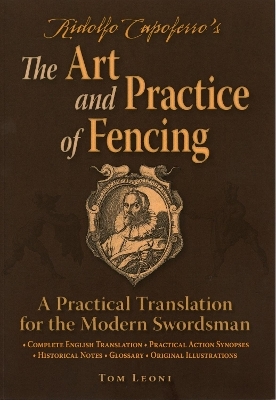
Ridolfo Capoferro's The Art and Practice of Fencing
Freelance Academy Press (Verlag)
978-0-9825911-9-2 (ISBN)
In the 1600s, the elegant and deadly Italian rapier was the choice sword of duelists, officers, gentlemen and noblemen: to master the rapier was to be a feared martial artist and a paragon in single combat.
Among the original treatises on the use of this weapon, the most prized by historical fencing revivalists in the last 150 year has been the Great Representation of the Art and Practice of Fencing, written in 1610 by Master Ridolfo Capoferro. In this remarkable text, Capoferro described and illustrated - in unmatched detail - the use of the rapier alone and with a left-handed dagger, cloak and shield, offering the modern historical fencing student a true wealth of Renaissance fencing theory, form and repertoire.
With this book, expert researcher and rapier instructor Tom Leoni offers a full, accurate and accessible English translation of Capoferro's teachings, complete with high-resolution reproductions of the 43 original illustrations. To make the book even more useful, Tom has included bullet-point synopses of all the actions illustrated by Capoferro, as well as a glossary of rapier-fencing terms with examples referring the reader to how they are used in the text. Also included is a primer on key rapier-fencing concepts and actions, as well as a historical introduction about Capoferro and his extraordinary relevance in the revival of historical martial arts.
Tom Leoni was born in Switzerland and grew up in Northern Italy. Since an early age, he developed a passion for antique arms and armour and Renaissance-Baroque culture. His meticulous research of Italian swordsmanship treatises helped him become an internationally-known teacher specialising in the Italian styles of the 1500s and 1600s. In 2005, Tom published an English translation of Master Salvator Fabris' 1606 rapier treatise Scienza d'Armi, one the of the most important fencing works of the late Renaissance. In 2009, he published a translation of Italy's earliest extant martial-arts treatise, Fiore de' Liberi's Fio di Battaglia (circa 1409).
Acknowledgments
Foreword
Introduction
Making Capoferro Accessible to the Modern Rapier Student
A Personal Journey
Who Was Ridolfo Capoferro?
The Two Faces of Capoferro: Period Literature Versus Victorian Scholarship
Jacopo Gelli: The Main 19th-Century Source on Capoferro
Capoferro, His Treatise and Its Importance to the Modern Student
Language, Translation, and Editorial Decisions
What You Need to Know to Tackle Capoferro
Additional Resources
Great Representation of the Art and Practice of Fencing
To the Most Serene Lord Don Francesco Maria Feltrio della Rovere, Sixth Duke of Urbino
To the Kind Reader
General Table of the Art of Fencing
Here Follows the Great Representation of the Practice of Fencing.
Beginning with the Explanation of the Difference Between Art and Practice
A Few Recommendations about Fencing
Explanation of Some Practical Fencing Terms
The Plates and Practical Synopses
Some Principles Regarding the Cut
A Failsafe Way to Defend Against Any Attack by Parrying with a Riverso and Always Striking with an Imbroccata
Glossary of Common and Useful Italian Rapier Fencing Terms
| Erscheint lt. Verlag | 31.12.2011 |
|---|---|
| Verlagsort | IL |
| Sprache | englisch |
| Maße | 178 x 254 mm |
| Themenwelt | Sachbuch/Ratgeber ► Sport ► Kampfsport / Selbstverteidigung |
| Geschichte ► Allgemeine Geschichte ► Neuzeit (bis 1918) | |
| Sozialwissenschaften ► Politik / Verwaltung | |
| ISBN-10 | 0-9825911-9-5 / 0982591195 |
| ISBN-13 | 978-0-9825911-9-2 / 9780982591192 |
| Zustand | Neuware |
| Haben Sie eine Frage zum Produkt? |
aus dem Bereich


